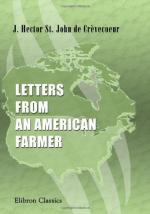In order to view the island in its longest direction from the town, I took a ride to the easternmost parts of it, remarkable only for the Pochick Rip, where their best fish are caught. I past by the Tetoukemah lots, which are the fields of the community; the fences were made of cedar posts and rails, and looked perfectly straight and neat; the various crops they enclosed were flourishing: thence I descended into Barrey’s Valley, where the blue and the spear grass looked more abundant than I had seen on any other part of the island; thence to Gib’s Pond; and arrived at last at Siasconcet. Several dwellings had been erected on this wild shore, for the purpose of sheltering the fishermen in the season of fishing; I found them all empty, except that particular one to which I had been directed. It was like the others, built on the highest part of the shore, in the face of the great ocean; the soil appeared to be composed of no other stratum but sand, covered with a thinly scattered herbage. What rendered this house still more worthy of notice in my eyes, was, that it had been built on the ruins of one of the ancient huts, erected by the first settlers, for observing the appearance of the whales. Here lived a single family without a neighbour; I had never before seen a spot better calculated to cherish contemplative ideas; perfectly unconnected with the great world, and far removed from its perturbations. The ever raging ocean was all that presented itself to the view of this family; it irresistibly attracted my




